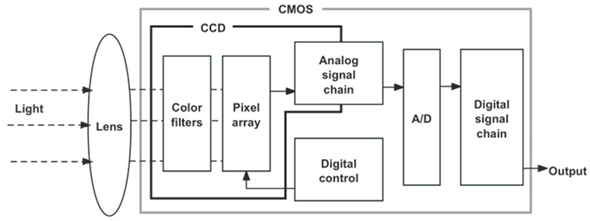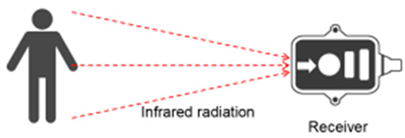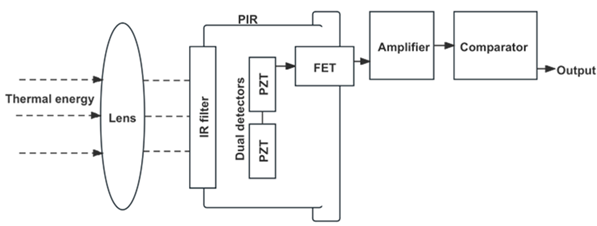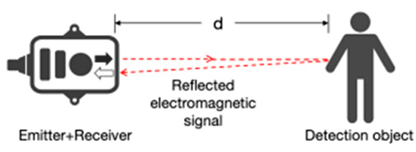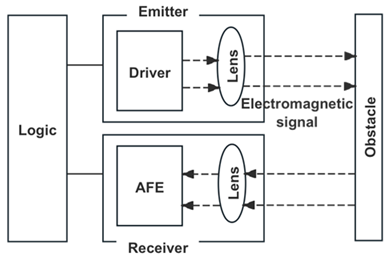Abstract
With the advancement of artificial intelligence, the home care environment for elderly users is becoming increasingly intelligent and systematic. The context aware human–computer interaction technology of sustainable aging-friendly smart homes can effectively identify user needs, enhance energy efficiency, and optimize resource utilization, thereby improving the convenience and sustainability of smart home care services. This paper reviews literature and analyzes cases to summarize the background and current state of context-aware interaction experience research in aging-friendly smart homes. Targeting solitary elderly users aged 60–74, the study involves field observations and user interviews to analyze their characteristics and needs, and to summarize the interaction design principles for aging-friendly smart homes. We explore processes for context-aware and methods for identifying user behaviors, emphasizing the integration of green, eco-friendly, and energy-saving principles in the design process. Focusing on the living experience and quality of life for elderly users living alone, this paper constructs a context-aware user experience model based on multimodal interaction technology. Using elderly falls as a case example, we design typical scenarios for aging-friendly smart homes from the perspectives of equipment layout and innovative hardware and software design. The goal is to optimize the home care experience for elderly users, providing theoretical and practical guidance for smart home services in an aging society. Ultimately, the study aims to develop safer, more convenient, and sustainable home care solutions.
1. Introduction
Since the 21st century, the rapid development of the Internet of Things (IoT) industry and mobile internet technology, along with the maturation of computer, communication, and sensor technologies, has propelled the establishment of cloud computing platforms, leading to significant breakthroughs in artificial intelligence (AI). Smart home technology, as an emerging comprehensive application, enables cross-platform and cross-device collaboration, allowing household products to intelligently interconnect and autonomously learn [1]. This has garnered widespread attention across various industry sectors.
The global population is aging, and many countries are transitioning into aging societies. According to the “World Population Aging Report” published by the United Nations Population Division in 2007, the proportion of people aged 60 and above in developed countries has already exceeded one-fifth, and it is projected that by 2050, nearly one-third of the population will be in this older age group. This trend highlights the growing importance of aging-friendly design. Aging-friendly design is a design philosophy centered around older adults, requiring careful consideration of their physical and psychological characteristics, as well as their behavioral habits and preferences, to create indoor environments that meet their needs. Developed countries like the United States, Japan, and several European nations, which started experiencing aging societies earlier, have made significant progress in home-based elder care by integrating cutting-edge technologies and developing various aging-friendly healthcare products with a focus on user experience. For example, Shabboo Valipoor et al. [2] from the University of Florida in the United States designed safer seating for older adults using electromyography and strength testing; Riitta Turjamaa et al. [3] comprehensively evaluated how smart homes can assist elderly users in home-based care through technological means, focusing on healthy aging. Ben-Tzion Karsh et al. [4] reviewed and analyzed research related to patient needs and characteristics from a clinical medicine perspective. They found that elderly patients with chronic illnesses often have diminished cognitive and motor abilities. Additionally, they emphasized the importance of usability testing in the design and development of CHITs, which refers to patient-focused interactive web- or technology-mediated applications. In the context of societal aging, researching how to enhance the age-friendliness of smart homes—utilizing the advantages of smart technology to ensure that elderly users can smoothly operate smart home systems—has become a critical issue in improving the quality of home-based elder care.
Smart home context-aware systems use sensor technology, data analysis, and artificial intelligence to achieve real-time monitoring and context recognition of the home environment, thereby providing personalized environmental control and services [5]. Context-aware systems based on multimodal user behavior recognition and multi-channel human–computer interaction improve recognition accuracy and combine contextual data for autonomous decision-making. For instance, the gesture recognition scheme based on multimodal fusion and Gaussian mixture models proposed by Jian-yang et al. [6] quantifies gestures through dynamic changes in WiFi signals, enhancing accuracy; Moeiz Miraoui et al. [7] inferred context by breaking down smart living room devices and utilizing machine learning, enabling home devices to proactively adapt to the environment. The home-based elder care contexts for elderly users are diverse, and by extensively collecting and analyzing contextual information, smart home systems can better understand user needs and provide personalized services, transitioning from passive feedback reception to proactive service delivery, automatically completing user tasks. Moreover, intelligent sensing and data analysis can optimize energy usage, contributing to green and sustainable development. Therefore, applying context-aware to smart home systems is key to enhancing user experience and achieving seamless and proactive smart home automation.
Currently, smart devices are in the exploratory phase of cross-end connectivity, with expectations of evolving towards proactive interaction and intelligent services in the future [8]. By achieving interconnectivity and contextual settings through intelligent ecosystems, smart home systems can seamlessly integrate spaces and devices, providing intelligent security, lighting, appliance control, audio–visual management, and window controls. This significantly reduces household energy expenses and fosters green economic transformation.
This paper focuses on elderly users living alone, combining context-aware theory and aging-friendly smart home interaction theory. By collecting contextual elements relevant to elderly users in smart homes, it explores methods for recognizing age-appropriate user behaviors in different contexts and studies the processes of context-aware in aging-friendly smart homes. The study proposes design methods for context-aware interactive experiences tailored to aging-friendly smart homes and exemplifies this with the scenario of elderly falls. This paper offers new ideas and methods for context-aware aging-friendly smart home services and user experience design, advancing the development of green smart homes and providing new pathways for achieving sustainable development goals and economic transformation.
2. Survey of Elderly Users Living Alone
This paper defines the target user group as elderly individuals aged 60 to 74 who are capable of self-care and live independently. At this stage, their health is generally good, although cognitive functions may begin to decline. They still possess clear logical thinking, have some experience with internet and smart products, and exhibit relatively high acceptance and understanding of emerging technology products. Currently, the use of smart homes requires a certain level of technological acceptance and learning ability. Smart home command control is performed through simple interactions such as touch, buttons, and voice commands. Context-aware services in smart homes are tailored based on user habits and preferences, utilizing machine learning and custom settings.
2.1. Characteristics of Elderly Users Aged 60–74
Physiological Characteristics: As individuals age, those between 60 and 74 years old experience noticeable physiological decline, primarily affecting motor functions, sensory perception, and cognitive abilities. There is a decrease in flexibility and coordination of movements, with gradual deterioration in vision, hearing, touch, taste, and smell. They may struggle with strong color contrasts, and their language and cognitive functions are impacted, leading to weakened memory, language communication, and executive function [9].
Psychological Characteristics: Elderly individuals aged 60 to 74 often feel a growing disconnect from the fast-paced societal environment, leading them to seek social respect and recognition. They are eager to gain a sense of fulfillment, respect, and opportunities for self-expression, desiring to be seen as independent and capable individuals rather than as people requiring preferential care in public settings.
Behavioral Characteristics: The behavioral traits of elderly users aged 60 to 74 typically include repetitive confirmation behaviors, help-seeking behaviors, autonomous learning behaviors, and health management behaviors. As memory declines, their cognitive habits tend to become more cautious and conservative, resulting in a tendency to repeatedly confirm information or new learning. When encountering difficulties during the learning process, they often seek external assistance to overcome barriers. Most elderly individuals in this age group have an educational background and maintain a pursuit of knowledge and enthusiasm for learning, showing willingness to embrace new things and try out smart products. Additionally, they place significant emphasis on health monitoring and management, covering various aspects such as diet, exercise, medical check-ups, and mental health.
2.2. Needs of Elderly Users Aged 60–74
To gain a comprehensive understanding of users’ home life and the use scenarios of smart home products, we conducted in-home observations and interviews with five independently living elderly households. (e.g., Figure 1) We carefully observed and analyzed their living conditions, product usage, and daily behavior habits, and recorded their living environments and product layouts. (e.g., Table 1).

Figure 1.
Home behavior observation records of elderly users.

Table 1.
User observation and interview results.
We observed that elderly individuals primarily follow a fixed daily routine, including activities such as personal hygiene, meals, household chores, and leisure, with most activities concentrated in the living room, kitchen, and bedroom. Traditional home appliances such as televisions, air conditioners, and lighting are used frequently, while the use of smart home products remains relatively low. However, there is a higher application of individual smart devices like smart cameras, smart speakers, and smart wristbands, although the degree of systematization and contextualization is not high. Elderly users’ home behaviors can be categorized into repetitive and occasional activities, with operation modes mainly involving buttons and touch screens, and occasional use of voice control.
Most middle-aged and elderly users prefer intuitive interaction methods such as voice control and simple touch commands, which reduce the difficulty of learning new technologies and make smart products more user-friendly for them. In terms of context-aware services, most respondents prefer simple and intuitive operation modes and are open to proactive services from smart homes, especially features that enhance safety and convenience, such as automatic alerts and health monitoring. However, they have expressed concerns about personal privacy and data security issues.
2.3. Interactive Design Principles for Aging-Friendly Smart Homes
Aging-friendly smart home design is based on the needs and usage conditions of elderly users, focusing on functional attributes, service categories, and user experience. The goal is to create a safe, comfortable, and convenient smart living environment. To analyze user needs and optimize the smart home experience for elderly individuals, the following interaction design principles have been summarized:
- Safety: Prevent risks by avoiding sharp or fragile items and ensuring electrical safety and reliability. Features such as automatic power-off and remote monitoring can be included.
- Ease of Use: Simplify the operation interface through intuitive interaction methods such as gesture control and light control. Enhance readability and interactivity with large fonts, high-contrast colors, and voice feedback.
- Adaptability: Smart facilities and functions should flexibly adapt to the needs of elderly users and changes in family structure. Address varying needs at different times and under different environmental conditions by using adjustable equipment and layouts. Context-aware technologies should enhance service autonomy and diversity.
- Emotional Engagement: Incorporate emotional care into the interaction experience, such as warm interfaces and voice services. Support remote social interactions like video calls and family photo sharing to alleviate feelings of loneliness. Additionally, provide automatic error correction features to improve command tolerance.
- Sensory Compensation: Use sensory compensation designs, such as tactile and auditory feedback, to assist information delivery. For example, vibration feedback, temperature change signals, and auditory guidance can help users perceive and operate the system effectively [10].
In summary, during the design process of smart homes, it is crucial to classify the needs of elderly users in detail, considering their unique physical characteristics and psychological changes, and analyze the relationships between potential needs and operations. In addition to ensuring that the functions and structure of smart home products are ergonomically suitable for elderly users, the design of smart home systems should emphasize the interaction experience. By integrating multimodal technology, context-aware technology, and machine learning, smart homes can automatically perform scene analysis, activity state analysis, and dynamic demand analysis during user behavior recognition and feedback processes. The system should respond reasonably to the habits of elderly users, transitioning from passive to proactive functionality to meet their expectations for practicality, ease of use, user-friendliness, and intelligence in smart homes.
3. Context-Aware Processes for Sustainable Aging-Friendly Smart Homes
In 1994, Schilit et al. [11] first introduced the concept of context-aware, a technology that quickly advanced in the field of computing due to its advantages in coordination and service prediction. Building on previous research, Dey [12] defined context-aware as systems that use contextual knowledge to provide relevant information or services to users. He categorized context-aware into two types: active and passive. Active context-aware involves information such as time and location, while passive context-aware focuses on user background and preferences. Since context aware systems utilize latent information from the environment to optimize their functionality and proactively deliver information and services best suited to user needs, the context-aware process must include context information collection, context information analysis, and context information decision-making [13]. The acquisition of contextual information primarily relies on sensor data collection or human–computer interface interactions. The collected contextual data are diverse and unordered, requiring abstraction processing to be interpreted by core data analysis systems. Furthermore, different contextual factors have varying influences and priorities in the decision-making process depending on the specific type of service.
(1) Context Information Collection for Sustainable Aging-friendly Smart Homes: This is the first step in the context-aware process, involving data acquisition from multiple sources. At this stage, smart home systems need to deploy various sensors and data collection mechanisms to capture and record critical context information in real time. Given the prominent needs of elderly users for health, safety, and emotional well-being, the collected context information can be categorized as follows [14,15]:
- User Context Elements: These include physiological, behavioral, and psychological characteristics of elderly users.
- Environmental Context Elements: These encompass information about sound, light intensity, location, temperature, and humidity.
- Device Context Elements: These pertain to device usage duration, functional status, and interaction modes.
(2) Context Information Analysis for Sustainable Aging-friendly Smart Homes: In the context-aware process for aging-friendly environments, context information analysis involves the in-depth processing and interpretation of collected data, aiming to extract meaningful patterns and insights from raw data. This step typically includes data preprocessing, feature extraction, and pattern recognition techniques, enabling the system to identify the behavior habits, preferences, and environmental changes affecting elderly users [16]. The analysis process can be divided into:
- Information Filtering: Identifying and eliminating erroneous data points, duplicate information, and data irrelevant to the current analysis goals.
- Information Synthesis: Extracting features, identifying patterns and trends from the data, and combining and integrating the filtered data to form a comprehensive understanding of user behavior, environmental information, and device status.
- Prioritization: Evaluating and determining the priority and urgency of different context information based on predefined criteria or the importance of the data, and adjusting response strategies accordingly.
(3) Context Information Decision-Making for Sustainable Aging-friendly Smart Homes: Context-aware decision-making is the core aspect of service provision in aging-friendly smart home systems. It enables the system to automatically adjust its functions, meeting the needs of elderly users, improving user experience, and promoting adaptive adjustments and energy savings within the smart home system, thereby playing a significant role in sustainable development. The strategies for implementing this process include:
- Responsive Decision-Making: This involves executing services based on the identification of specific commands from elderly users, such as voice, gesture, or touch, combined with context information to provide on-demand services, thereby avoiding unnecessary energy consumption.
- Predictive Decision-Making: This approach employs complex data processing and analysis algorithms, such as machine learning and artificial intelligence technologies, to learn user habits and recommend services. By using visual, auditory, and tactile feedback, predictive services can be recommended to elderly users, including inquiries and choices for the next steps, to achieve optimal energy usage efficiency. For instance, when the smart home system detects that an elderly user is cooking, it analyzes the activity patterns, predicts cooking behavior, and suggests services such as whether to activate the range hood, open windows for ventilation, or adjust the heat level.
- Proactive Decision-Making: This method involves perceiving user intentions based on environmental factors, device status, and user behavior preferences, and interpreting multimodal information. The system not only responds to and predicts needs but also proactively offers services even in the absence of explicit requests. For example, if a solitary elderly user falls, the system will automatically alert and use a voice assistant to comfort the user, providing self-rescue measures.
4. User Behavior Recognition Methods in Aging-Friendly Smart Homes
In the smart home environment, there are rich information modalities, including user voice, gestures, activities, and environmental factors such as temperature, humidity, and odors. Accurate recognition and input of this information are crucial for the intelligent services of smart homes. Accurate user behavior recognition is a key aspect of smart home research and serves as the foundation for home products to meet user needs and function intelligently. In the context aware interactive experience design of aging-friendly smart homes, speech recognition, touchless gesture recognition, and non-contact activity recognition eliminate the need for elderly users to learn complex operation guides or engage in physical contact [17,18,19]. This reduces the technological barrier to using smart home systems, allowing elderly users to interact with these systems in a natural and intuitive way. Consequently, this significantly enhances the home experience for elderly users.
4.1. Speech Recognition
Speech recognition enables elderly users to issue commands to smart home systems through spoken language without the need for physical contact with external devices. This significantly enhances the convenience and efficiency of interaction, reducing the technological learning curve for elderly users. Speech recognition is commonly used in smart home device control, automatic voice-to-text generation, and interactions with intelligent voice assistants. To implement speech recognition, electronic recording devices (microphones) capture voice information, which is then processed and analyzed using sound processing hardware and speech recognition algorithms [20]. In the construction of context aware systems for aging-friendly smart homes, the dialog interaction architecture of intelligent voice assistants is based on front-end development frameworks. This provides a paradigm for user interaction interfaces, where the core control system executes and interprets voice commands and generates feedback responses during interactions (e.g., Figure 2). Intelligent voice assistants can connect with multiple terminal devices, such as smart control screens, smart speakers, and smart displays, acting as a bridge for user–device interaction and device-to-device interconnectivity. Elderly users can call upon the intelligent voice assistant to execute simple, direct commands, such as changing lighting modes, opening or closing curtains, playing music, and controlling security systems. Additionally, they can converse with the assistant to query information such as temperature, news, and time, thereby facilitating better command execution and enhancing their overall experience with smart home functionalities.
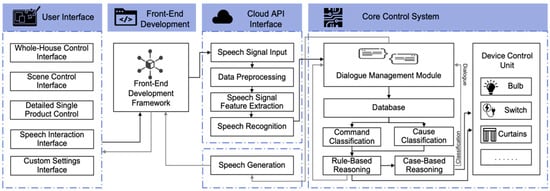
Figure 2.
Intelligent voice assistant architecture based on dialog interaction.
4.2. Gesture Recognition
Smart home products controlled by user gestures utilize predefined joint coordinate information for different scenarios, allowing users to control devices and settings with hand movements. In aging-friendly smart homes, gesture recognition provides significant benefits for elderly users, especially those with speech impairments or slow movements, by alleviating the difficulties associated with complex buttons or touch controls. This technology enhances operational convenience and adds an element of enjoyment to the interaction. Gesture recognition employs cameras, depth sensors, infrared sensors, and other devices to capture user gestures, enabling functions such as air gestures for muting, playing/pausing, and volume control [21]. (e.g., Table 2) This method of gesture control eliminates the need for cumbersome remote controls, allowing elderly users to interact with smart home systems from a distance, providing greater freedom in their activities. Elderly users can use gestures such as palm waving, fist clenching, and lateral movements to navigate and control smart screens, including moving, selecting, confirming, switching pages, zooming, and rotating. Additionally, gestures like finger pointing up or down and fist clenching can be used to control the power and temperature of air conditioners, making the interaction with smart home devices more intuitive and accessible.

Table 2.
Commonly used gestures for aging-friendly smart home parts.
4.3. Non-Contact Activity Recognition
In aging-friendly smart homes, applying non-contact sensors to recognize user activities is crucial. By combining context-aware technology, these systems can capture and understand user actions and intentions in the most natural and unobtrusive way, thereby providing appropriate intelligent services. Common non-contact activity recognition sensors include optical image sensors, passive infrared sensors, and active electromagnetic sensors [22,23,24] (e.g., Table 3). For elderly users, non-contact activity recognition reduces the complexity of device interaction and offers significant advantages in maintaining home safety, real-time health monitoring, and in enhancing the convenience of daily life. The system monitors relevant data such as the activity area, activity level, and bodily movements (e.g., standing, lying down, sitting) of elderly users. When abnormal behavior patterns are detected, the system can provide various intelligent services. For instance, if the system records frequent nighttime awakenings of an elderly user, it can alert family members and provide potential cause analyses. Additionally, if the system detects a fall and the user is unable to stand, it can automatically notify family members or emergency services.

Table 3.
Non-contact sensors are commonly used in aging smart homes.
Overall, selecting the appropriate sensing technology for user behavior recognition in smart homes is crucial for enhancing the accuracy of behavior analysis and optimizing the user experience. Speech recognition allows elderly users to control home devices through simple spoken commands, offering convenience for those with limited hand mobility or impaired vision. Gesture recognition enables users to control devices through natural hand movements, enhancing the intuitiveness and naturalness of interactions. Non-contact activity recognition plays a key role in ensuring user safety and health monitoring, particularly in detecting falls and recognizing abnormal behaviors, ensuring that users receive timely assistance when they are unable to seek help themselves. These recognition methods gather information from the dynamically changing home environment and the diverse behaviors of users, increasing the autonomy and safety of elderly users. This, in turn, helps aging-friendly smart home systems to make accurate predictions and provide appropriate functional feedback.
5. Context-Aware Interactive Experience Design for Aging-Friendly Smart Homes
5.1. Model Architecture for Context Aware Interactive Experience in Aging-Friendly Smart Homes
For smart home systems targeting elderly users, it is crucial to build an efficient and comfortable context-aware user experience. This requires a comprehensive and systematic analysis from the perspectives of information input, analysis, and output. Smart home systems utilize multimodal sensors to gather information about users, products, and the environment. They collect signal data changes caused by different behaviors, integrate user commands with contextual information, and provide data support to the smart home control system. By relying on hardware functionality linkage and software multimodal interaction interfaces, these systems offer service feedback to users, thereby constructing a high-quality home care experience. Based on the aforementioned context aware processes and user behavior recognition scenarios for aging-friendly smart homes, this paper develops a context-aware interactive experience model. This model is tailored to the product and functional needs of elderly users in their daily lives. (e.g., Figure 3).
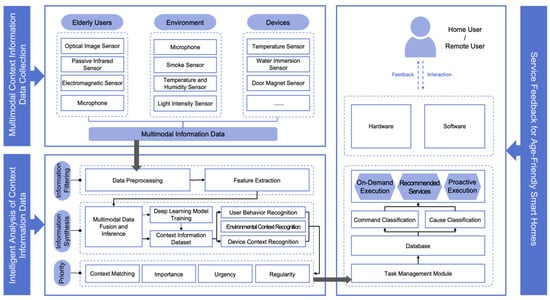
Figure 3.
Multimodal situational awareness user experience model.
- (1)
- Multimodal Context Information Data Collection
A user-centric information collection mechanism is employed, covering a wide range of sensor technologies, including light sensors, active electromagnetic sensors, passive infrared sensors, and microphones. These sensors meticulously capture user location, activity trajectories, gestures, and voice information. Additionally, environmental information sensors, such as temperature and humidity sensors, light sensors, and smoke detectors, provide supplementary data collection, recording variables like ambient temperature, humidity, light intensity, and smoke concentration in detail. Furthermore, the usage information regarding household devices, such as device temperature and the status of doors and windows, is precisely collected through corresponding sensors. This comprehensive multimodal context information data collection strategy ensures thorough monitoring of the elderly user’s living environment, providing rich raw data for subsequent intelligent analysis.
- (2)
- Intelligent Analysis of Context Information Data
During the data processing and analysis phase, this model outlines the process and standards for context analysis in aging-friendly smart homes through three sub-steps: information filtering, information synthesis, and prioritization. The goal is to extract meaningful context information from raw data for analysis. The technical route for intelligent analysis includes both local data analysis and cloud data analysis. Initially, data conversion is completed within the sensors, with bidirectional digital signal connections between microcontrollers, potentially using programmable read-only memory for digital compensation. Subsequently, using cloud computing technology and various deep learning algorithms, data preprocessing, feature extraction, multimodal data fusion and inference, and deep learning model training are conducted in the cloud. This ensures data quality, enabling the system to accurately recognize key information such as user location and body posture. This intelligent analysis process provides solid data support for the autonomous optimization and precise service of aging-friendly smart home systems.
- (3)
- Service Feedback in Aging-friendly Smart Homes
Based on the accurate recognition of user behavior and context information, the aging-friendly smart home control system can provide timely and appropriate service feedback. The system comprehensively analyzes the recognition results and implements decision-making methods such as on-demand execution, recommended services, and proactive execution to meet the immediate and future needs of elderly users. For home care service needs, the system adopts diverse data feedback presentation methods, including functional adjustments of hardware products, subsystem control, product linkage, and scenario linkage. Additionally, through multimodal interaction methods such as voice assistant interaction, touch interface interaction, air gesture interaction, and non-contact proactive interaction, the system provides elderly users with a rich interactive experience.
The construction of the aforementioned context-aware user experience model for aging-friendly smart homes is centered around the user. It builds the product interaction experience from both data collection and feedback perspectives, meeting the multimodal feature extraction needs for user output information and the multi-channel perception experience needs for received information. In the data intelligent analysis module, the model incorporates changes in user and contextual information to recognize user behavior in a more comfortable, efficient, and natural manner. This approach has significant value in improving the usability of smart home products and reducing the cognitive load on users.
5.2. Typical Application Scenarios of Context-Aware Aging-Friendly Smart Homes—A Case Study of Fall Detection
- (1)
- Smart Home Device Layout for Fall Detection
When designing fall detection scenarios for elderly users based on context-aware technology, it is crucial to consider the types and layout of smart home devices. Different types of sensors and control devices should be deployed in various rooms to ensure comprehensive monitoring and quick responses. “Considering human factors engineering principles for work environment design is a good practice for improving the interaction between patient users, the technology, and the environment. Lighting, noise, and thermal comfort are the most common environmental aspects to consider” [4]. The following is a smart home device layout plan divided by room (e.g., Figure 4).
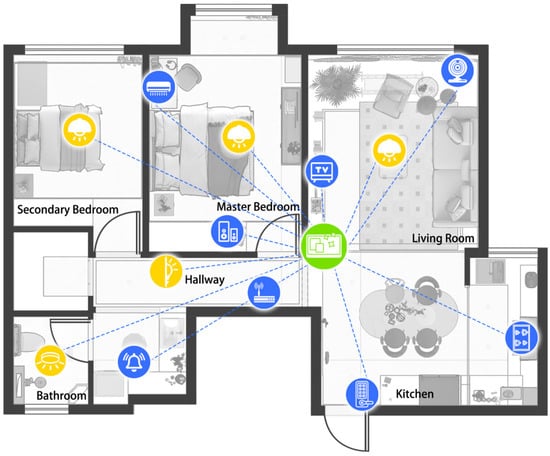
Figure 4.
Smart home device layout with a fall as an example.
This smart home system layout covers areas from the living room and hallway to the bedroom, creating an all-encompassing monitoring network to ensure the safety and convenience of elderly users living at home. It selects suitable device models and placements based on the actual conditions in the user’s home, ensuring stability and safety. The system is equipped with smart TVs, air conditioners, and speakers to enhance entertainment and emotional engagement. Cameras and sound sensors are installed in the living room and bathroom to monitor sound and image information in real time. Additionally, smart stoves and door locks are included to ensure cooking safety and provide emergency access services. Infrared sensor lighting devices are installed in all rooms to monitor abnormal activities and adjust lighting for clarity and comfort. Finally, all data are aggregated to a smart terminal, ensuring that the smart home system can quickly respond to emergencies such as falls, providing necessary assistance promptly to mitigate potential injuries.
- (2)
- User interface
The design of the aging-friendly smart terminal user interface prioritizes the display of contextual modes and quick services, presenting environmental and device information intuitively under the current context. The interface emphasizes personalized and continuous context aware services, highlighting subsystem and sub-scenario settings while placing the independent management of smart home devices in secondary modules. Considering potential vision and hand operation limitations of elderly users, the control panel is designed with large buttons and visual icons to ensure a simple, intuitive, and easy-to-understand interface. (e.g., Figure 5).

Figure 5.
(a) “Sub-scenario” interface high-fidelity design, (b) “Personal center” interface high-fidelity design.
The sub-scenario configuration mainly reflects the integration of functions and systems, evolving smart home control from individual smart devices to intelligent scenarios. The system provides different applicable scenario services based on the space the elderly user is in. For example, if the system detects a fall and locates the user in the bathroom, the interface displays “ceiling light monitoring”, “smart surveillance”, and “voice assistant reminders”, achieving integrated services under context-aware. The personal customization page allows users to set preferences like volume, color, and font size, using large, visual icons and actual device images to display the categories of devices. Users can freely drag and drop items when customizing scenes, enabling connected devices to function in coordination.
- (3)
- Hardware
In the design of aging-friendly smart home systems, the intelligent ceiling light serves as a critical sensor product, providing not only illumination but also the capability to detect the activities of elderly users. Its concealed sensors minimize the intrusive nature of the device, enhancing the sense of privacy and safety, and improving the comfort of the home care experience. The design integrates sensor technology with intelligent control algorithms to achieve dynamic environmental adaptation and proactive services. With a simple aesthetic, the warm-toned lighting harmonizes with the indoor environment. The light fixture automatically adjusts brightness and color temperature to reduce visual strain, and it includes emergency response and safety monitoring features, such as detecting abnormal activities like falls and adjusting lighting for alerts. The modular design of the multi-modal sensor meets the various detection needs of different elderly users. An illustration of the smart ceiling light design is shown in Figure 6.
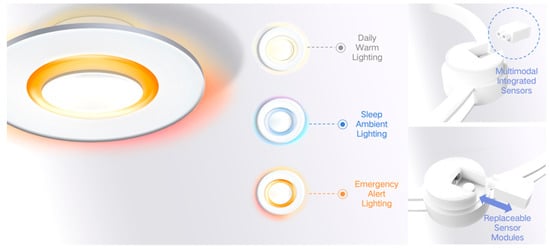
Figure 6.
Design renderings of intelligent ceiling lights.
Centered around the context-aware interactive experience model of aging-friendly smart homes, we designed an aging-friendly scenario based on the intelligent ceiling light to address high-risk events such as falls. (e.g., Figure 7) When an elderly user falls, infrared sensors detect the change, and the intelligent ceiling light immediately switches to orange-red warning lighting. The smart lighting system adjusts brightness to avoid energy waste. The system activates security cameras for confirmation and uses a voice assistant for emergency notifications and emotional reassurance. If other family members are present, the lighting in the corresponding rooms also changes color and triggers an alarm; if the user is alone and requires community assistance, the system sets a one-time password for the smart door lock to facilitate quick rescue, while notifying family members through an app, providing details of the fall, and supporting remote video or voice communication. From a market perspective, the cost of this product solution is manageable and relatively low.

Figure 7.
Smart home scene design with a fall as an example.
- (4)
- Evaluation
Calvin Kalun Or et al. [25] provides an overview of three classical usability inspection methods and their applications: heuristic evaluation, cognitive walkthrough, and pluralistic walkthrough. An in-depth analysis of the inspection methods is provided through a real case study. The less common usability checking methods are summarized, including person-based checking, feature checking, action analysis, and consistency checking. Usability testing methods have been expanded. In reference to these usability testing methods, we designed an experiment to conduct the following usability evaluation.
The evaluation focused on the effectiveness of a smart home system designed for elderly individuals aged 60–74 living alone, particularly assessing the impact of context-aware active service design in fall scenarios. By comparing an experimental group using context-aware interaction design with a control group utilizing traditional home design, we analyzed subjective evaluations across multiple dimensions. These dimensions included subjective anxiety levels, user interface usability, operational simplicity, context-aware system interaction experience, safety, system response speed, and overall satisfaction.
Data were collected using a five-point Likert scale (1 = very dissatisfied, 5 = very satisfied) for subjective scoring and analyzed using paired t-tests for demand analysis. The results indicated a significant difference in the interaction experience with the context-aware system (t = 11.24, p < 0.01) and user interface usability (t = 6.85, p < 0.01). This demonstrates a significant disparity in the experience levels between the two groups, with the experimental group showing marked improvements in user interface usability, context-aware system interaction experience, and overall satisfaction. (t-value: a larger absolute t-value indicates a greater difference between the experimental and control groups. p-value: a p-value less than 0.05 indicates statistical significance) (e.g., Table 4).

Table 4.
Likert scale calculation results.
This experiment validates the effectiveness of the context-aware interaction design in smart home systems for enhancing user experience, particularly in the areas of user interface usability, context-aware system interaction experience, and overall satisfaction. However, the differences in subjective anxiety levels, safety, system response speed, and operational simplicity were not significant, suggesting that these dimensions require further optimization in future designs. Overall, the application of context-aware systems in smart home design shows promising potential, but ongoing research and improvement are necessary to fully enhance user experience and system performance (e.g., Figure 8).
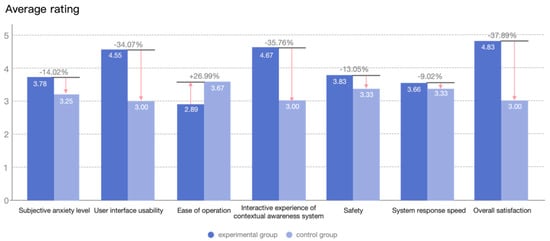
Figure 8.
Data comparison chart.
6. Conclusions and Future Scopes
This paper, set against the backdrop of sustainable development and AI-driven economic transformation, explores research hotspots and deficiencies in context-aware aging-friendly smart homes through literature review and case analysis, emphasizing the optimization of resource utilization and energy efficiency. The research proposes a design methodology by constructing a context-aware interactive experience model, innovating in multimodal user behavior recognition, intelligent context information analysis, and multimodal service feedback to reduce energy consumption and optimize device management. Using elderly falls as an example, the study designs a smart home service with precise response needs, providing a reference for innovation in elderly home care services, and opening new avenues for achieving sustainable development goals. In the context of smart aging, this paper, aimed at optimizing the home care experience for elderly users, forms a design approach for context-aware interactive experiences in aging-friendly smart homes, which holds theoretical significance. Additionally, the typical scenario design and aging-friendly smart product innovation, exemplified by elderly falls, offer important references for exploring the deep integration of context-aware technology with aging-friendly smart home services, contributing significantly to technological innovation and market development in the smart-aging sector.
Currently, research on context-aware aging-friendly smart home interactive experiences is still in the exploratory development stage, with some limitations. First, in user research, due to the low usage of smart homes by elderly users and their lack of experience, core needs research is not sufficiently typical. The user interface design lacks in-depth research on the needs and experiences of users with different cognitive abilities. Secondly, on the technical front, inconsistent communication protocols between different devices affect information interoperability, resulting in insufficient device linkage. The response speed and stability in multi-user collaboration scenarios require optimization. Rapid technological advancements and iterations may render older software and hardware components obsolete, increasing the load and reducing performance. Improvements are needed in sensor battery usage and replacement schemes, necessitating effective modular design and power management solutions. Lastly, regarding privacy and security, sensor monitoring devices may pose risks of user information leakage, requiring enhanced data protection measures.
Future research will focus on exploring the actual needs and experiences of elderly users, analyzing their diverse activity contexts in home life. We will actively seek examples of aging-friendly home activity scenarios and product designs, enhancing the context-aware interactive feedback mechanisms through technological innovation and design optimization. Additionally, the research will aim to provide precise information support, reduce the memory burden on elderly users, and focus on the human-centered dimension of service design, particularly addressing the usability of voice and gesture recognition. We will explore ways to optimize these technologies to accommodate elderly users’ operational errors and better understand and respond to user intentions. Further expanding the application scenarios of context aware aging-friendly smart homes, integrating multimodal interactive experiences, and providing elderly users with a safer, more comfortable, and convenient home living experience will drive technological innovation and market development in the smart home field, realizing the social vision of smart aging.
Author Contributions
Conceptualization, Y.L.; Methodology, L.Z. and M.W. (Mengyao Wang); Software, L.Z. and A.Z.; Validation, S.Z. and M.W. (Minghua Wang); Formal analysis, M.W. (Mengyao Wang); Investigation, Y.L. and L.Z.; Resources, A.Z. and S.Z.; Data curation, M.W. (Mengyao Wang) and S.Z.; Writing—original draft, Y.L., L.Z. and M.W. (Mengyao Wang); Writing—review & editing, A.Z., M.W. (Mengyao Wang), S.Z. and M.W. (Minghua Wang); Visualization, L.Z. and M.W. (Minghua Wang); Supervision, Y.L. and M.W. (Minghua Wang); Project administration, Y.L. All authors have read and agreed to the published version of the manuscript.
Funding
This study was supported by The National Social Science Foundation of China (Grant No. 23VSZ090).
Data Availability Statement
The datasets used and/or analyzed during the current study are available from the corresponding author on reasonable request.
Conflicts of Interest
Author Lejia Zhou was employed by Beijing Automotive Technology Institute Center Company Limited. The remaining authors declare that the research was conducted in the absence of any commercial or financial relationships that could be construed as a potential conflict of interest.
References
- Li, Y.C.; Ghazilla, R.A.R.; Abdul-Rashid, S.H. QFD-Based Research on Sustainable User Experience Optimization Design of Smart Home Products for the Elderly: A Case Study of Smart Refrigerators. Int. J. Environ. Res. Public Health 2022, 19, 13742. [Google Scholar] [CrossRef] [PubMed]
- Valipoor, S.; Pati, D.; Stock, M.S.; Bazuin, D. Safer chairs for elderly patients: Design evaluation using electromyography and force measurement. Ergonomics 2018, 61, 902–912. [Google Scholar] [CrossRef] [PubMed]
- Turjamaa, R.; Pehkonen, A.; Kangasniemi, M. How smart homes are used to support older people: An integrative review. Int. J. Older People Nurs. 2019, 14, e12260. [Google Scholar] [CrossRef] [PubMed]
- Karsh, B.; Holden, R.J.; Or, C.K.L. Human factors and ergonomics of health information technology implementation. In Handbook of Human Factors and Ergonomics in Health Care and Patient Safety, 2nd ed.; CRC Press: Boca Raton, FL, USA, 2011; pp. 249–264. [Google Scholar]
- Masai, K.; Kunze, K.; Sakamoto, D.; Sugiura, Y.; Sugimoto, M. Face commands-user-defined facial gestures for smart glasses. In Proceedings of the IEEE International Symposium on Mixed and Augmented Reality (ISMAR), Recife, Brazil, 9–13 November 2020; pp. 374–386. [Google Scholar]
- Ding, J.; Wang, Y.; Si, H.; Ma, J.; He, J.; Liang, K.; Fu, S. Multimodal Fusion-GMM based Gesture Recognition for Smart Home by WiFi Sensing. In Proceedings of the 2022 IEEE 95th Vehicular Technology Conference: (VTC2022-Spring), Helsinki, Finland, 19–22 June 2022; pp. 1–6. [Google Scholar]
- Miraoui, M.; El-Etriby, S.; Tadj, C. A Hybrid Modular Context Aware Services Adaptation for a Smart Living Room. Intell. Autom. Soft Comput. 2018, 24, 299–307. [Google Scholar] [CrossRef]
- Yang, M.; Huang, H.; Yuan, H.; Sun, Q. Interaction Design of Products for the Elderly in Smart Home Under the Mode of Medical Care and Pension. In Proceedings of the HCI International 2016—Posters’ Extended Abstracts: 18th International Conference, HCI International 2016, Toronto, ON, Canada, 17–22 July 2016; Springer International Publishing: Berlin/Heidelberg, Germany, 2016; pp. 145–156. [Google Scholar]
- Duan, Q.; Fang, K.; Liu, M.; Pan, Y. Design Research of Geriatric Rehabilitation Products Based on Natural Interaction. In Proceedings of the HCI International 2016—Posters’ Extended Abstracts: 18th International Conference, HCI International 2016, Toronto, ON, Canada, 17–22 July 2016; Springer International Publishing: Berlin/Heidelberg, Germany, 2016; pp. 426–431. [Google Scholar]
- Cho, M.E.; Kim, M.J. Characterizing the interaction design in healthy smart home devices for the elderly. Indoor Built Environ. 2014, 23, 141–149. [Google Scholar] [CrossRef]
- Schilit, B.; Adams, N.; Want, R. Context-awareness computing applications. In Proceedings of the Workshop on Mobile Computing Systems and Applications, Washington, DC, USA, 8–9 December 1994; pp. 89–101. [Google Scholar]
- Abowd, G.D.; Dey, A.K.; Brown, P.J.; Davies, N.; Smith, M.; Steggles, P. Towards a Better Understanding of Context and Context-awareness. In Proceedings of the 1st International Symposium on Handheld and Ubiquitous Computing, Karlsruhe, Germany, 27–29 September 1999; Springer: Berlin, Germany, 1999. [Google Scholar]
- Park, J.S.; Kim, S.H. Noise Cancellation Based on Voice Activity Detection Using Spectra Variation for Speech Recognition in Smart Home Devices. Intell. Autom. Soft Comput. 2020, 26, 149–159. [Google Scholar]
- Bissoli, A.; Lavino-Junior, D.; Sime, M.; Encarnação, L.; Bastos-Filho, T. A Human-Machine Interface Based on Eye Tracking for Controlling and Monitoring a Smart Home Using the Internet of Things. Sensors 2019, 19, 859. [Google Scholar] [CrossRef] [PubMed]
- Ranieri, C.M.; MacLeod, S.; Dragone, M.; Vargas, P.A.; Romero, R.A.F. Activity recognition for ambient assisted living with videos, inertial units and ambient sensors. Sensors 2021, 21, 768. [Google Scholar] [CrossRef] [PubMed]
- Kołakowska, A.; Szwoch, W.; Szwoch, M. A Review of Emotion Recognition Methods Based on Data Acquired via Smartphone Sensors. Sensors 2020, 20, 6367. [Google Scholar] [CrossRef] [PubMed]
- Muaaz, M.; Chelli, A.; Gerdes, M.W.; Pätzold, M. Wi-Sense: A passive human activity recognition system using Wi-Fi and convolutional neural network and its integration in health information systems. Ann. Telecommun. 2021, 77, 163–175. [Google Scholar] [CrossRef]
- Nan, M.; Trăscău, M.; Florea, A.M.; Iacob, C.C. Comparison between Recurrent Networks and Temporal Convolutional Networks Approaches for Skeleton-Based Action Recognition. Sensors 2021, 21, 2051. [Google Scholar] [CrossRef] [PubMed]
- Anbarasan; Lee, J.S.A. Speech and Gestures for Smart-Home Control and Interaction for Older Adults. In Proceedings of the 3rd International Workshop on Multimedia for Personal Health and Health Care, Seoul, Republic of Korea, 22 October 2018; pp. 49–57. [Google Scholar]
- Kim, S.; Metze, F. Dialog-context aware end-to-end speech recognition. In Proceedings of the 2018 IEEE Spoken Language Technology Workshop (SLT), Athens, Greece, 18–21 December 2018; pp. 434–440. [Google Scholar]
- Lu, Y.; Wang, X.; Gong, J.; Zhou, L.; Ge, S. Classification, Application, Challenge, and Future of Midair Gestures in Augmented Reality. J. Sens. 2022, 2022, 3208047. [Google Scholar] [CrossRef]
- Polo, A.; Salucci, M.; Verzura, S.; Zhou, Z.; Massa, A. Real-Time CSI-Based Wireless Gesture Recognition for Human-Machine Interaction. In Proceedings of the 2021 10th International Conference on Modern Circuits and Systems Technologies (MOCAST), Thessaloniki, Greece, 5–7 July 2021; pp. 1–4. [Google Scholar]
- Al-QANESS, M.A.A. Device-free Human Micro-Activity Recognition Method Using WiFi Signals. Geo-Spat. Inf. Sci. 2019, 22, 11. [Google Scholar] [CrossRef]
- Lu, Y.; Zhou, L.; Zha, S.; Zhuo, X.; Ge, S. Application of Deep Learning and Intelligent Sensing Analysis in Smart Home. Sensors 2024, 24, 953. [Google Scholar] [CrossRef] [PubMed]
- Or, C.K.; Chan, A.H.S. Inspection methods for usability evaluation. In User Experience Methods and Tools in Human-Computer Interaction; CRC Press: Boca Raton, FL, USA, 2024; pp. 170–192. [Google Scholar]
Disclaimer/Publisher’s Note: The statements, opinions and data contained in all publications are solely those of the individual author(s) and contributor(s) and not of MDPI and/or the editor(s). MDPI and/or the editor(s) disclaim responsibility for any injury to people or property resulting from any ideas, methods, instructions or products referred to in the content. |
© 2024 by the authors. Licensee MDPI, Basel, Switzerland. This article is an open access article distributed under the terms and conditions of the Creative Commons Attribution (CC BY) license (https://creativecommons.org/licenses/by/4.0/).







